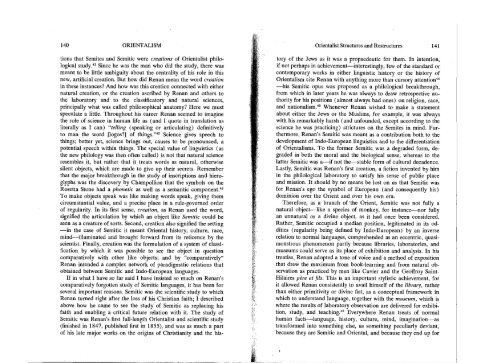Orientalism - autonomous learning
Orientalism - autonomous learning
Orientalism - autonomous learning
You also want an ePaper? Increase the reach of your titles
YUMPU automatically turns print PDFs into web optimized ePapers that Google loves.
00 1 ..<br />
L<br />
140 ORIENTALISM<br />
Orientalist Structures and Restructures<br />
141<br />
tions that Semites and Semitic were creations of Orientalist philological<br />
study.41 Since he was the man who did the study, there was<br />
meant to be little ambiguity about the centrality of his role in this<br />
new, artificial creation. But how did Renan mean the word creation<br />
in these instances? And how was this creation connected with either<br />
natural creation, or the creation ascribed by Renan and others to<br />
the laboratory and to the classificatory and natural sciences,<br />
principally what was called philosophical anatomy? Here we must<br />
speculate a little. Throughout his career Ren!ln seemed to imagine<br />
the role of science in human life as (and I quote in translation as<br />
literally as I can) "telling (speaking or articulating) definitively<br />
to man the word [logos?] of things."42 Science gives speech to<br />
things; better yet, science brings out, causes to be pronounced, a<br />
potential speech within things. The special value of linguistics (as<br />
the new philology was then often called) is not that natural science<br />
resembles it, but rather that it treats words as natural, otherwise<br />
silent objects, which are made to give up their secrets. Remember<br />
that the major breakthrough in the study of inscriptions and hieroglyphs<br />
was the discovery by Champollion that the symbols on the<br />
Rosetta Stone .had a phonetic as well as a semantic component. 43<br />
To make objects speak was like making words speak, giving them<br />
circumstantial value, and a precise place in a rule-governed order<br />
of regularity. In its first sense, creation, as Renan used the word,<br />
signified the articulation by which an object like Semitic could be<br />
seen as a creature of sorts. Second, creation also signified the setting<br />
-in the case of Semitic it meant Oriental history, culture, race,<br />
mind-illuminated and brought forward from its reticence by the<br />
scientist. Finally, creation was the formulation of a system of classification<br />
by which it was possible to see the object in question<br />
comparatively with other like objects; and by "comparatively"<br />
Renan intended a complex network of paradigmatic relations that<br />
obtained between Semitic and Indo-European languages.<br />
If in what I have so far said I have insisted so much on Renan's<br />
comparatively forgotten study of Semitic languages, it has been for<br />
several important reasons. Semitic was the scientific study to which<br />
Renan turned right after the loss of his Christian faith; I described<br />
above how he came to see the study of Semitic as replacing his<br />
faith and enabling a critical future relation with it. The study of<br />
tory of the Jews as it was a propaedeutic for them. In intention,<br />
if not perhaps in achievement-interestingly, few of the standard or<br />
contemporary works in either linguistic history or the history of<br />
<strong>Orientalism</strong> cite Renan with anything more than cursory attention 44<br />
-his Semitic opus was proposed as a philological breakthrough,<br />
from which in later years he was always to draw retrospective authority<br />
for his positions (almost always bad ones) on religion, race,<br />
and nationalism. 45 Whenever Renan wished to make a statement<br />
about either the Jews or the Muslims, for example, it was always<br />
with his remarkably harsh (and unfounded, except according to the<br />
science he was practicing) strictures on the Semites in mind. Furthermore,<br />
Renan's Semitic was meant as a contribution both to the<br />
development of Indo-European linguistics and to the differentiation<br />
of <strong>Orientalism</strong>s. To the former Semitic was a degraded form, degraded<br />
in both the moral and the biological sense, whereas to the<br />
latter Semitic was a-if not the-stable form of cultural decadence.<br />
Lastly, Semitic was Renan's first creation, a fiction invented by him<br />
in the philological laboratory to satisfy his sense of public place<br />
and mission. It should by no means be lost on us that Semitic was<br />
for Renan's ego the symbol of European (and consequently his)<br />
dominion over the Orient and over his own era.<br />
Therefore, as a branch of ' the Orient, Semitic was not fully a<br />
natural object-like a species of monkey, for instance-nor fully<br />
an unnatural or a divine object, as it had once been considered.<br />
Rather, Semitic occupied a median position, legitimated in its oddities<br />
(regularity being defined by Indo-European) by an inverse<br />
relation to normal languages, comprehended as an eccentric, quasimonstrous<br />
phenomenon partly because libraries, laboratories, and<br />
museums could serve as its place of exhibition and analysis. In his<br />
treatise, Renan adopted a tone of voice and a method of exposition<br />
that drew the maximum from book-<strong>learning</strong> and from natural observation<br />
as practiced by men like Cuvier and the Geoffroy Saint<br />
Hilaires pere et fils. This is an important stylistic achievement, for<br />
it allowed Renan consistently to avail himself of the library, rather<br />
than either primitivity or divine fiat, as a conceptual framework in<br />
which to understand language, together with the museum, which is<br />
where the results of laboratory observation are delivered for exhibition,<br />
study, and teaching. 46 Everywhere Renan treats of normal<br />
Semitic was Renan's first full-length Orientalist and scientific study ';; human facts-language, history, culture, mind, imagination-as<br />
(finished in 1847, published first in 1855), and was as much a part<br />
transformed into something else, as something peculiarly deviant,<br />
of his late major works on the origins of Christianity and the his-<br />
because they are Semitic and Oriental, and because they end up for
















